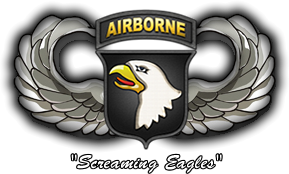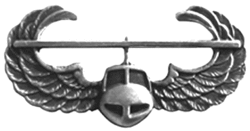
Doing some research on the post Vietnam decision to go to one airborne division I came across this fascinating article by Charles S. Bloodworth. I thought readers here would be interested. It features some relatively unknown history about the development of the air assault badge and the Army’s transitioning of the 101st from an airborne to an air assault division.
An Excerpt from the “History of the 101st (Post-Vietnam)” By Charles S. Bloodworth
Edited by Will Rodriguez
When the 101st Airborne Division returned to Fort Campbell, Kentucky, from Viet Nam in February 1972, about all that returned were the unit colors, and a command group with a few staff officers and senior NCOs. Almost all soldiers, SSG and below, were immediately discharged when they arrived at Oakland, California, or Seattle, Washington. The 101st Airborne, then called the 101st Airborne Division (Airmobile), returned to buildings vacated by the recently inactivated “U.S. Army Training Center, Fort Campbell, Kentucky.” Major General John Cushman was the Commanding General, but he had a headquarters with no hindquarters.
The 101st was almost exactly 1/3 airborne. That is, the Third Brigade (the former 173rd Airborne Brigade, with the Geronimos of 1-503rd and 2-503rd Infantry, and the Rakkasans of 3-187th Infantry) were on jump status. First Brigade (1-327th and 2-327th Infantry and 2-502nd Infantry) and Second Brigade (1-501st Infantry, 1-502nd Infantry, and 1-506th Infantry) were leg. One third of the division support elements were airborne on status, the other two-thirds were straight leg. So, for example, the 326th Engineer Battalion had one airborne company, but two leg companies. Same for the 501st Signal Battalion, the 311th Military Intelligence Battalion, and so on.
This organization wasn’t really as bizarre as it sounds. After all, early during WWII the 101st wasn’t 100% parachute. Then it was 1/3 parachute and 2/3 glider forces. Under the theory of “the helicopter is the new glider,” the airborne were to provide a light, fast vertical envelopment/assault capability, while the airmobile elements would follow up with sustained and heavier forces. At one time the Division Museum (Pratt Museum) at Fort Campbell even had a spectacular mural painted the length of one wall. It showed the 3rd Brigade parachuting in and seizing an airfield in the manner of the Rangers at Point Salinas, Grenada. Once the airfield was secured, a fleet of C-130s and C-141s were depicted landing and disgorging the 1st and 2nd Brigades, with UH-1 Huey and AH-1 Cobra helicopters. The airmobile elements then fanned out, linked up, and defeated the enemy. But it couldn’t happen without recruiting a division’s worth of soldiers, one third of them airborne.
A massive push was underway to recruit soldiers to refill the division. The draft had ended, this was the time of VOLAR (Volunteer Army). Soldiers had to be recruited, with slogans such as “Today’s Army Wants You.” Recruiters were given recruiting incentives, such as “Unit of Choice” (guaranteeing that the recruit would be assigned to a specific unit); “Station of Choice” (guaranteeing that the recruit would be assigned to a specific location); “Airborne Duty Option” (guaranteeing airborne training and a jump slot assignment); there were of course MOS guarantees, and so on. Every soldier in the Division was told he was to be an assistant recruiter. The Pathfinders and the 3rd Brigade did parachute demonstrations in front of county fairs, and at high schools. We showed movies at malls, and did static displays with parachutes, radios, AK-47s and other weapons in the court house square of cities all around Fort Campbell.
Obviously one of our biggest draws was to wear our Class A uniforms, with a garrison cap with glider patch, backgrounds on our wings, and trousers bloused into spit-shined jump boots. And it worked. We recruited hundreds of young men, perhaps thousands, who came into the Army under a much- reduced threat of being sent into combat. There was enhanced pay and GI Bill benefits, and the elimination of many of the irritants to service life that were part of the Army until that point: Saturday morning muster formations, weekend passes, KP duty. These men came into the 101st with a guarantee of Unit or Station of Choice 101st Airborne/Fort Campbell and airborne duty status. Jump pay for enlisted men was $55.00 per month, a considerable bonus for a soldier with $300 – $400 per month in base pay. Hazardous duty pay alone could provide a respectable car payment in 1972.
By 1973 the mix of airborne and non-airborne soldiers, with the difference in pay and prestige, was causing serious morale problems. Fights were not uncommon. Airborne soldiers not assigned to a jump slot were occasionally jumping, either legally (with permissive no-pay orders) or illegally (sneaking onto aircraft with the connivance of jumpmasters who might be their roommate). In an effort to keep a uniform appearance, even the leg soldiers were permitted to wear the garrison cap with glider patch and bloused boots, but of course they had no wings. That was heresy to the truly Airborne. Then matters reached critical mass when the Department of the Army pulled the entire 101st Division off jump status.
That was an even greater morale crisis, as jump pay was stopped, but car payments continued. Also, it appeared that the 101st would be forced to revert wearing low quarter shoes and the round service hat (derisively called the “bus driver hat” by Airborne soldiers). The Army doesn’t use the expression “breach of contract.” The correct wording is “unfulfilled enlistments” and suddenly the 101st was facing hundreds, if not thousands of them. Those recruited under the Unit/Station of Choice and Airborne options couldn’t have both. They had three choices:
– Waive the Unit/Station of Choice and transfer to another unit on jump status. In 1973 this meant the 1st Battalion (Airborne), 509th Infantry in Italy (that’s pretty far from Tennessee/Kentucky); or the arch-rival 82nd Airborne Division, or;
– Waive the Airborne Duty Option and stay with the 101st at Fort Campbell, but possibly wear the same uniform every other leg in the Army was wearing, or;
– Demand an immediate Honorable Discharge, with VA benefits if they had been in 180 days. This last option looked pretty good to a lot of soldiers.
What was the command to do? MG John Cushman was being transferred to be Commandant of the Military Academy, and MG Sid Berry was his successor. In a stroke of genius, a solution was found that saved the day and created a new badge. Years before, the 101st had created and run what they called the Recondo School, a kind of mini-Ranger course. After instruction of hand-to-hand combat, patrolling, field craft, and intensive physical challenges the graduates had been awarded a “Recondo Badge.” It was a local wear item, much like the Jungle Expert badge in Panama, or the “Pro-Life Pin” of MG Hank “The Gunfighter” Emerson in Korea. You joined the unit, you attended a short course, you earned it, you wore it while you were in the unit, and when you left you took it off. The 101st dusted off the Recondo School program of instruction and created the Airmobile Badge. That’s right, it was originally called the Airmobile Badge. Locally designed and fabricated, the badge was deliberately crafted to mimic the glider wings of WWII, which hadn’t been issued since the 1950s. The nose of the Huey took the place of the glider body, and the horizontal rotor blade was the spitting image of the glider wing.
Soldiers could attend a five-day yes, five-day training program and be awarded the Airmobile Badge. “In the tradition of the glider troops,” who, remember, were 2/3 of the WWII 101st Airborne Division, they could bear the badge with the cloth colored background as if they were on jump status. They could wear the garrison cap with glider patch and the coveted bloused boots. From five meters away they were indistinguishable from a real paratrooper. Now everybody in the division could look like an Airborne soldier.
Real Airborne soldiers took an immediate dislike to the Airmobile Badge. Look closely at one. Now imagine coloring in the two front windows of the Huey with a black pen. Now color in the two lower chin windows and the space between them. Finally, color in the wings left and right with two black circles. Yes, it bears a remarkable likeness to Mickey Mouse. We called them “mouse wings” and by the time I left the 101st in 1974 it was still not possible to post a picture of the badge at Fort Campbell without some Airborne trooper coming by with a black felt tip marker and turning it into “Mickey Mouse wings.”
Well, it took a little more tuning up. The badge had to be renamed something sexier, like the “Air Assault Badge,” and the class was stretched to ten days, but to be frank, it was a gimmick. The Air Assault school didn’t teach anything the typical 101st soldier didn’t already know or was taught at the unit level. 101st soldiers were sling loading, rappelling, climbing up and down trooper ladders from the aft ends of hovering CH-47s and setting up PZs and LZs in combat in Viet Nam, years before the air assault badge was created. But it worked. We avoided the massive hemorrhage of soldiers. When the soldiers left the 101st Airborne Division, the badge came off, its mission accomplished.
Then how did the Air Assault Badge become a permanent wear item? As every Airborne soldier knows, there is one and only one Program of Instruction at Airborne School. From private to general, everybody goes through the same training minute by minute, mile for mile, pushup for pushup. The same rules apply for Ranger, Special Forces, and Pathfinder. I assume that also applies to SCUBA and HALO, but I haven’t been there so I don’t know. But early in its history the Air Assault School, in a stroke of genius, created an A Course, a B Course, and a C Course. The A Course is for the average soldier. They must stand inspection formations, get dropped for pushups, double-time everywhere, etc.
But then there is the B Course, for field grade officers (majors and above) and senior NCOs. They were allowed to come to the school each morning an hour late, skipping the inspection formation and the accompanying push-ups and chickenshit. They were gently led to the front of every line, coached on tasks, allowed to enter and exit the classrooms first, and generally handled warmly. No harsh words, and no stress. Then there was the C Course, for general officers. The C Course lasted one week. They were spoon-fed the instruction, examinations were one-on-one, and nobody watched the clock too closely on the timed runs.
The result of the B and C Courses was predictable. In barely two years the Army had a large number of senior officers and NCOs who were not Airborne qualified, but who had breezed through a special program of instruction and received the Air Assault Badge while at Fort Campbell. They wore the badge, with the accoutrements of the Airborne. But since it was a temporary wear local item, they had to remove it when they left Fort Campbell. It wasn’t long before the Pentagon and the Military Personnel Center had a good number of field grade officers and senior NCOs who had received the Air Assault badge, but couldn’t wear it or put it in their personnel records. The result: the Air Assault Badge quickly became a permanent wear item. As Paul Harvey would say: “And now you know the rest of the story.”


